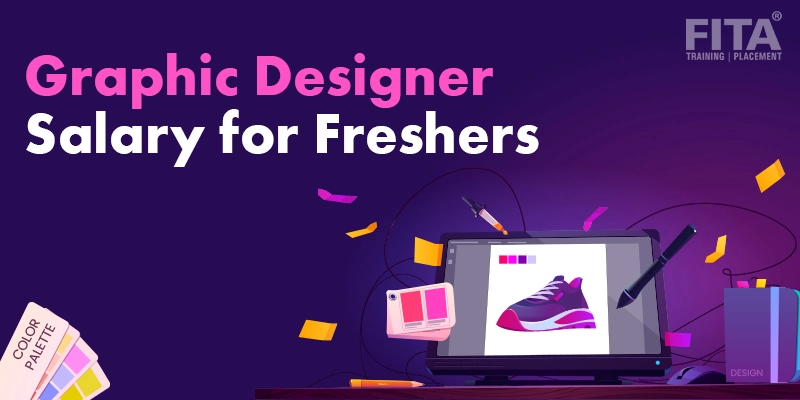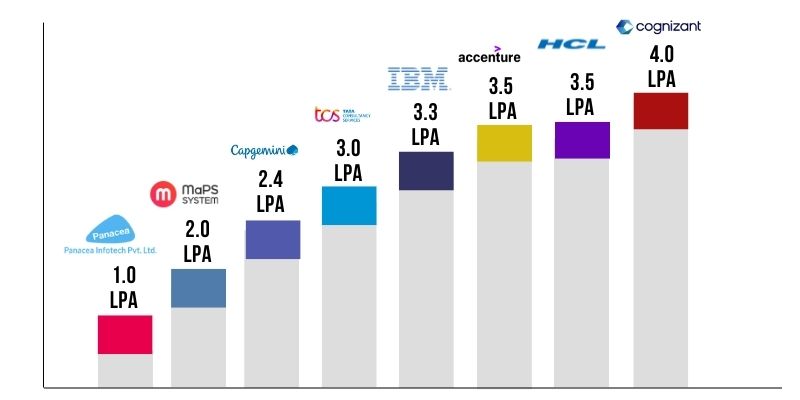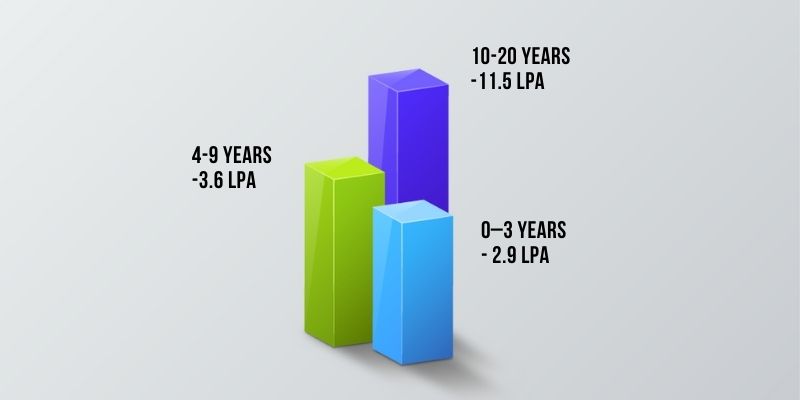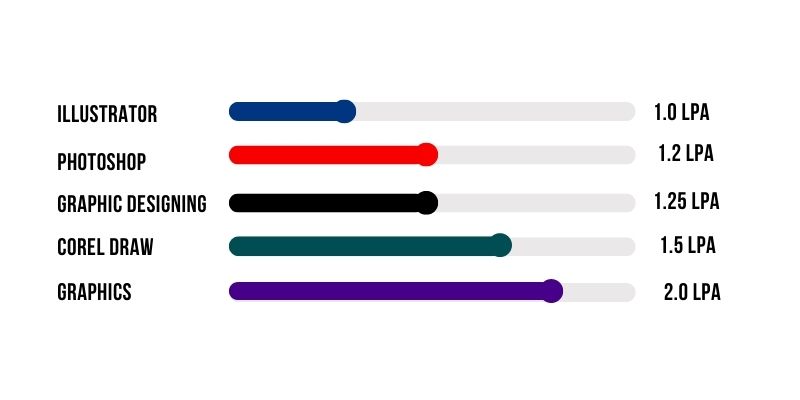
Graphic Designers are in high demand as businesses shift to the digital landscape. In today’s competitive market, every company needs a strong online presence, and visual content plays a crucial role in attracting customers. From social media graphics to brochures and billboards, graphic designers shape a brand’s identity and marketing strategy. Their creativity drives engagement, making them essential across industries. If you’re aspiring to become a graphic designer, this guide will explore the role, industry demand, and Graphic Designer Salary for Freshers.
From start-ups to MNCs, graphic designers are getting competitive salary in today’s job market. If you have strong base in web designing and logo designing, you can be easily get hired. Launching a career as a Graphic needs a strong skill-set relevant to the field. By joining a Graphic Design Courses in Chennai at FITA Academy, you can acquire all the skills needed to thrive in the field.
Salary of a Graphic Designer in India
The average salary of graphic designer in india ranges from Rs. 3 LPA – Rs. 10 LPA according to recent research. Depending on your experience and location, salaries can vary. A Graphic Designer is an expert in designing all types of graphics related things such as logos, posters, brochures, flyers etc. They needs to design these items so that it attracts attention of target audience and helps them to understand what you want to convey.
A Graphic Designer has to keep in mind various factors like fonts, colors, shapes, etc. while designing any item. They need to use their creativity and innovative ideas to create eye-catching designs. Graphic design scope in india seems to be bright in upcoming years. So, if you are planning to start your career as a Graphic Designer then you should first decide your goal and choose right career path. Then only you can achieve success in future.
Earnings of a Graphic Designer Based on Different Companies
Graphic designers in India are in high demand as the country’s burgeoning economy has created an increasing number of businesses and organizations that need a professional design team to help create their branding, marketing materials, and more. While the salary range for graphic designers can vary depending on the company they work for. Here are list of Salary Range of differnt companies shown some of approximated salary range by ambition box.

Based on the graphic designer salary range image, it is evident that the salary range for graphic designers varies depending on the company. Additionally, some graphic designers may make earn more than others, depending on their skills and experience. To upskill yourself through Graphic Design Online Course will be beneficial to you and your career.
Earnings of a Graphic Designer Based On Work Experience
According to a recent study, graphic designers in India with 0 to 3 year experince can expect to make anywhere from Rs 2.9 lakh per year and Graphic Designer salary per month is around 20,000 depending on the level of experience they have. Salaries for designers with five or more years of experience are highest, while those with less experience are paid less. Graphic designers who specialize in branding and advertising are typically paid the most.

Salary Range Based on Skills
Graphic designers are known for their creative and innovative works. They can design logos, labels, packaging, and other graphics that can help an organization or product stand out from the rest. It is important to have strong skills in Adobe Photoshop, Illustrator, InDesign, and CorelDRAW in order to be successful as a graphic designer. Here is approximated salary of graphic designer in india range from ₹3 LPA – ₹10 LPA based on skills according to ambition box.

How to Become a Graphic Designer?
Choosing whether you want to work with print media or digital media is the first step in becoming a graphic designer. Print media includes magazines, newspapers, books, catalogs, leaflets, etc. whereas digital media means websites, blogs, social networking sites, mobile applications, etc.
After deciding your choice you should go for a certification course from reputed institute like FITA Academy. This Graphic Design Courses in Bangalore will help you to gain more knowledge regarding this subject. Once you complete your certificate course you should apply for a Graphic Designer Job.
Did You Know?
“Nowadays there are lots of companies hiring Graphic Designer candidates. You just need to search for the suitable company according to your requirement.”
What are the Responsibilities of Graphic Designers?
Graphic designers are responsible for creating visual identities for brands and organizations. They do this by employing computer technologies to produce unique visuals to help businesses attract customers and retain existing ones. This role requires extensive knowledge of typography, color theory, layout, and digital media creation.
The job description varies depending on the type of organization one works for, but here are some of the most common responsibilities:
- Conceptualizing, designing, formatting, and supervising print production while conforming with deadlines
- Communicating with clients to work out requirements
- Collaborating with brand owners to develop creative ideas
- Creating logos, posters, flyers, brochures, advertisements, and packaging
- Developing marketing campaigns and web graphics
- Managing social media accounts
“Also Read: Different Types of Graphic Design”
Different Graphic Designer Job Profiles
In the business and product world, graphic designers develop graphics for companies, brands, and products. They work closely with marketing teams to develop visual assets such as logos, brand identities, advertisements, packaging, and promotional materials.
Graphic designers use software programs like Adobe Illustrator, Photoshop, InDesign, CorelDraw, etc., to create images and layouts for print media. The job profile of a graphic designer varies depending upon the type of industry they work in. Some companies hire graphic designers to create logos, while others require them to create brochures, posters, flyers, banners, and even web pages. Graphic designers are usually employed full-time by large corporations or small firms. The earnings of a graphic designer have been increasing today and are expected to reach great heights in future.
Creative Director
It is the responsibility of the creative director to ensure that the overall look and feel of the project is on point. They ensure that the product stays on-track while keeping aesthetics and artistic integrity intact. A creative director must constantly be aware of how the final product looks like, what it represents, and how it fits into the brand or industry.
The person who holds this position oversees the entire process from concept development to production, including post-production. He/she acts as the visionary for the project, providing guidance and direction throughout the creation process. In addition, he/she ensures that the product’s design and other aesthetic aspects remain on track. The average web designer job salary ranges from ₹12 LPA – ₹30 LPA, depending on experience and location.
Web Designer
This role is responsible for creating visually appealing and user-friendly websites. They design anything from simple websites to complex e-commerce platforms and mobile applications. Web designers use tools like Adobe Photoshop, Figma, and HTML/CSS to create engaging interfaces. Many companies hire web designers to enhance their online presence. While formal education isn’t necessary, taking a web design course can be beneficial. A web designer can earn on the scale of ₹3.5 LPA – ₹10 LPA on averge, depending on experience and location. This is based on the report of graphic design career salary by ambition box. You can learn essential skills with a Web Designing Course in Chennai and become a creative director.
UI Designer
The role of a user interface designer is to create the look and feel of a product based on the requirements it has. They help businesses understand what their target audience wants and how it interacts with their products. This person is responsible for creating a visual layout of a product or site. A UI design professional is often involved in the development process. You might even hear about a UI designer working directly with developers.
UI designers work closely with usability experts and graphic artists to ensure that sites and apps are easy to use and navigate. As a user interface designer, the first step in becoming successful is to have a solid understanding of HTML and CSS. Learn basic coding and learn how to code within a framework like Bootstrap 4. UI designers can expect to earn between ₹5.5 LPA – ₹18 LPA. Learn UI UX Designer Course in Chennai and master these skills to start a career in UI UX.
Graphic Designer
Graphic designers create logos, icons, illustrations, and other designs that represent a company or business. These professionals are responsible for developing a unique style that helps brands stand out from competitors.
Graphic designers usually have experience in a variety of different mediums, such as print, web, motion graphics, and so forth. Some specialize in certain areas, such as typography, illustration, or photography. Others may be versatile and able to work across multiple platforms. Graphic design jobs salary range from ₹3 LPA – ₹10 LPA, with experienced Graphic designer Salary will be higher.
Brand Identity Designer
This role works on visual identity, like logos, color schemes, typography, and other marketing factors. They work with development and marketing teams to create a unique image for a brand that matches with the company’s goals. Their work helps businesses establish a strong presence in the market. The demand for skilled brand identity designers is high, especially in advertising agencies and startups. Indian graphic designer salary including this role ranges from ₹4 LPA – ₹12 LPA. Taking Graphic Design Courses in Coimbatore will be helpful to build a strong base in the field.
Animator
Animators are responsible for creating complicated graphics. In fact, animators are often referred to as “graphic designers.” However, there are some differences between the two jobs. While a graphic designer creates images that are meant to represent ideas and concepts, an animator creates images that tell stories. This includes animation sequences that accompany text and video. An animator can also create 2D animations or 3D models. The latter requires more skill and knowledge since they need to know how to model characters and set them up for animation. Salaries for animators typically range from ₹4 LPA – ₹15 LPA, with experienced professionals earning significantly more.
Salary of Freelance Graphic Designer
Freelance works usually do not have fixed pay. They may vary for every individual’s skill level, and the type of clients they work with. Here’s the breakdown of freelance graphic designer pay in india:
- Beginner (0-2 years experience): ₹2 lakh – ₹5 lakh per year
- Mid-level (3-5 years experience): ₹5 lakh – ₹12 lakh per year
- Experienced (6+ years experience): ₹10 lakh – ₹25 lakh+ per year
Freenlancer often charge rates based on the project level they assign or the number of hours they work for. For hour-based tasks, the pay approximately ranges from ₹500 to ₹5,000 per hour, depending on expertise and client requirements. High-end freelance designers working with international clients can earn significantly more graphic design wage. Want to unlock high-paying opportunities? Upskill with a Graphic Design Courses in Pondicherry and earn upto a lakh in a month.
Graphic Designer Interview Questions and Answers
Here are some basic graphics designer interview questions and answers provide a great overview of graphic design and its core principles.
1. What is the importance of Communication in Graphic Design?
Graphic design is about using different mediums (e.g., typography, illustration, photography, animation) to communicate ideas effectively. The value of graphic design lies in its ability to merge various disciplines and solve problems visually.
2. What are the Priorities in Design?
The most important priority for a designer is solving the problem at hand. While perspectives may vary on the relative importance of typography vs. content, the designer must consider the audience and situation. Ultimately, the design should resolve the problem and meet specific goals.
3. How 3D Graphic Art is Helpful?
3D graphics allow designers to create more accurate and realistic representations of objects. It’s particularly useful for understanding and visualizing products like cars or buildings, offering a more immersive approach to design.
4. What is Adobe Pagemaker?
Pagemaker is a desktop publishing tool used for designing printed materials. It’s helpful for creating brochures, flyers, catalogs, and even PDFs, emphasizing the versatility of the software in various types of design work.
5. Core Principles of Graphic Design?
- Contrast: The relationship between different design elements to draw attention.
- Proportion: The balance of space and size between objects in a design.
- Rhythm: The repetition of patterns to guide the viewer’s eye across the design.
- Color: Sets moods, emphasizes points, and creates visual appeal.
- Visual Hierarchy: The organization of design elements from most to least important.
You can learn Graphic Design from the scratch to the advanced tools and make yourself familair with popular design tools with a course Graphic Design Courses in Madurai.
6. What is the difference Between a Logo and a Brand Identity?
A logo is a symbol or mark representing a company, while brand identity encompasses the full visual representation, including logos, colors, fonts, and other design elements, creating a cohesive identity across all platforms.
These points showcase the broad range of skills and knowledge a graphic designer should possess, from technical software expertise to an understanding of design principles and communication strategies.
“Explore more about Interview Tips and prepare for graphic designer interviews.”
Launching a design career can be both exciting and rewarding, especially for freshers looking to explore the creative industry. The entry-level graphic design careers salary will vary on factors like skills, location, and the demand. In fact, the UI UX Developer Salary for Freshers tends to be higher due to the growing demand for user-friendly digital experiences. By continuously upgrading skills and building a strong portfolio, freshers can unlock better opportunities and achieve long-term success in the dynamic field of graphic design.
Frequently Asked Questions (FAQ)
What is the Graphic designer salary for freshers in india?
A graphic designer in India earns between ₹3 LPA to ₹10 LPA. The salary for every person may vary based on their skill-set, experience they have in the relevant field, and location. Freelancers and senior designers can earn more.
Is graphic designing a good career in india?
Yes, starting a career in graphic design is a wise choice as every business is in competition to make their brand’s presence. You can earn through a full-time role from an employer or by getting freelance design projects.
What is the Graphic Designer salary in TamilNadu?
In Tamil Nadu, graphic designers earn around ₹2.5 lakh to ₹8 lakh per year. The salary depends on experience, company, and industry. Freelancers may earn more based on projects.
What is the Graphic Designer salary in Chennai?
“Graphic designers in Chennai earn ₹3 lakh to ₹9 lakh per year. The salary varies based on expertise, company, and industry demand. Experienced professionals can earn higher salaries.”
What is the Graphic Designer salary in Zoho?
At Zoho, graphic designers earn approximately ₹5 lakh to ₹12 lakh per year. The salary depends on experience, role, and performance. Senior designers may earn even more.
What is the Salary of a graphic designer per month?
“A graphic designer’s monthly salary ranges from ₹25,000 to ₹80,000. This depends on skills, experience, and the company they work for. Freelancers can earn more based on projects.”
How to earn money as a graphic designer in India?
Graphic designers can earn through full-time jobs, freelancing, and selling design templates.
